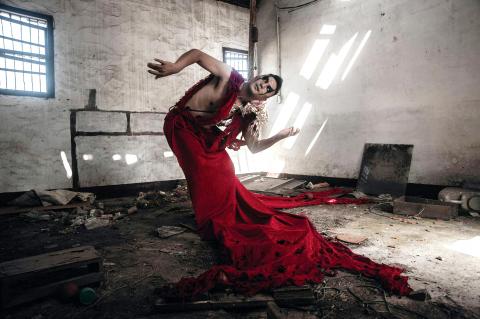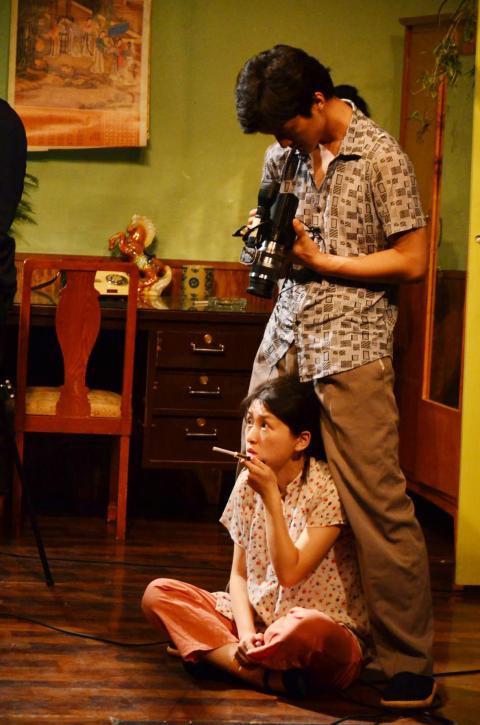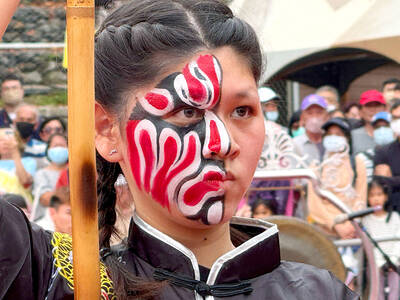The Taipei Arts Festival (TAF, 台北藝術節) celebrates its 15th birthday this year with a program of 11 shows, some already with an established reputation, others original works that will premiere at the festival. The Taipei Arts Festival is the smaller, cheekier, relation to the much grander, if younger, Taiwan International Festival of the Arts (台灣國際藝術節) that took place earlier this year, and it has very much its own attitude and ambition.
“Our budget is limited, and unlike many larger arts festivals, we are not really in a position to buy established [international] names,” Keng Yi-wei (耿一偉), artistic director for the festival said in a phone interview with the Taipei Times last week. “No one will have anything to say against bringing in such shows, but in fact all you are doing is transporting hit shows from London or Avignon to Taipei. This is not what the Taipei Arts Festival wants to do. We already have the Taiwan International Festival of the Arts, which is more like a standard arts festival, bringing over big names from overseas. The list of choices is limited, and so I particularly want to emphasize something different.”
Keng said that TAF has taken an active role in providing input for new works created by artists for the festival. “Half of our programs are works that are collaborations between Taiwan artists and foreign artists … Moreover our choices are more youth-oriented, and are perhaps more creative.”

Photo courtesy of TAF
As an example, Keng mentioned that this year is the 200th anniversary of Richard Wagner’s birth. “Many arts festivals around the world will put on a Wagner opera. We can’t begin to afford something like that, so instead we created something quite different.” Keng was referring to Big Bang Wagner, an eclectic work featuring French-born performance artist Anne Tismer, musician Moritz Gagern from Germany and writer Jade Chen (陳玉慧) from Taiwan. The work is described as “a groundbreaking performance combining an exhibition, performance and electronic music party,” in the publicity material. The ticket includes audience admission to the show’s after party.
This predisposition for putting a new spin on the classics can be seen also in Theatre du Reve Experimental’s Thunderstorm 2.0, a reworking of the modernist classic by Chinese playwright Cao Yu (曹禺). The performance group from Shanghai “is dedicated to refreshing the stagnant theater scene in Beijing,” and its members work to develop experimental theater in several different directions, such as political, physical, documentary, multimedia and cross-cultural theater. Thunderstorm 2.0 would have Cao Yu spinning in his grave, but that is pretty much the idea.
The festival also features acts that are emerging onto the mainstream, such as Timber! by Cirque Alfonse of Canada, an alternative act that has emerged from the far-reaching inspiration of Cirque du Soleil. Set against a background of a logging community in Quebec, the actors perform feats of strength and agility against a rollicking soundtrack of traditional music of Quebec using many self-made props. There is also Andre & Dorine by the Kulunka Theatre Company of Spain, a show of masked performers serving as full-sized puppets and dealing with the complex emotions of an elderly couple coping with the devastation of Alzheimer’s disease.

Photo courtesy of TAF
The trans-cultural spirit of TAF is probably best exemplified by Red Demon (赤鬼), a production by Ex-Theater Asia, a group founded by Indian director Chongtham Jayanta Meetei and the Taiwanese actress Lin Pei-ann (林浿安) and starring Fangnas Nayao Pacilailai, an Amis Aborigine from Taitung County and Miyuki Kamimura from Japan, among others.
Of the 11 works in this year’s show, seven follow the developmental direction set by last year’s festival, “international co-productions with Taipei at their core,” in which foreign artists are invited to develop shows with Taiwan artists, pushing artistic boundaries in new directions. The theme this year is “exploring new worlds.” Keng said that while the scope of new adventure is diminishing in the real world, art still has many unexplored regions to which artists could travel if they only dared.
Extensive English-language information about the festival and the shows can be found at the festival Web site eng.taipeifestival.org.tw. The festival opens August 1 and runs until Sept 8.

The People’s Republic of China (PRC) last week offered us a glimpse of the violence it plans against Taiwan, with two days of blockade drills conducted around the nation and live-fire exercises not far away in the East China Sea. The PRC said it had practiced hitting “simulated targets of key ports and energy facilities.” Taiwan confirmed on Thursday that PRC Coast Guard ships were directed by the its Eastern Theater Command, meaning that they are assumed to be military assets in a confrontation. Because of this, the number of assets available to the PRC navy is far, far bigger

The 1990s were a turbulent time for the Chinese Nationalist Party’s (KMT) patronage factions. For a look at how they formed, check out the March 2 “Deep Dives.” In the boom years of the 1980s and 1990s the factions amassed fortunes from corruption, access to the levers of local government and prime access to property. They also moved into industries like construction and the gravel business, devastating river ecosystems while the governments they controlled looked the other way. By this period, the factions had largely carved out geographical feifdoms in the local jurisdictions the national KMT restrained them to. For example,

The remains of this Japanese-era trail designed to protect the camphor industry make for a scenic day-hike, a fascinating overnight hike or a challenging multi-day adventure Maolin District (茂林) in Kaohsiung is well known for beautiful roadside scenery, waterfalls, the annual butterfly migration and indigenous culture. A lesser known but worthwhile destination here lies along the very top of the valley: the Liugui Security Path (六龜警備道). This relic of the Japanese era once isolated the Maolin valley from the outside world but now serves to draw tourists in. The path originally ran for about 50km, but not all of this trail is still easily walkable. The nicest section for a simple day hike is the heavily trafficked southern section above Maolin and Wanshan (萬山) villages. Remains of

Shunxian Temple (順賢宮) is luxurious. Massive, exquisitely ornamented, in pristine condition and yet varnished by the passing of time. General manager Huang Wen-jeng (黃文正) points to a ceiling in a little anteroom: a splendid painting of a tiger stares at us from above. Wherever you walk, his eyes seem riveted on you. “When you pray or when you tribute money, he is still there, looking at you,” he says. But the tiger isn’t threatening — indeed, it’s there to protect locals. Not that they may need it because Neimen District (內門) in Kaohsiung has a martial tradition dating back centuries. On